The Surface 3 Review
by Brett Howse on May 4, 2015 9:00 AM ESTDisplay
When Surface Pro 3 moved to a 3:2 aspect ratio, it made a lot of sense. 16:9 in a tablet makes for a very poor experience, and in a laptop, it is not much better. Almost everyone has moved to 16:9 in the laptop space and the lack of vertical height can make for a less than ideal experience. Most web content is vertical, and working in Office means you want vertical space as well. The widescreen does help with two windows snapped open at once, but I always find myself craving more vertical room.
On a tablet, I feel that 16:9 is even worse. Holding a 16:9 device in one hand can feel very heavy due to the length of the tablet, and turning it to portrait means that it is very tall and skinny. The move to 3:2 really squares up the device, and makes it a lot more balanced in either direction. Holding it in one hand is much easier, and finally portrait mode is usable on the Surface.
So the aspect ratio is a big improvement. The display size also has a slightly wider corner to corner of 10.8 inches versus 10.6 inch model that came before this. The actual width of the display is about 9 inches, compared to 9.2 on the outgoing Surface 2 model. The display height is now 6 inches, up from 5.2, so the total area of the display is almost 54 square inches, up from 48 inches on the outgoing model.
To fill this display, we have a Panasonic panel with a resolution of 1920x1280. This is roughly the same pixel density as the Surface Pro 3’s slightly larger 12 inch 2160x1440 display, coming in at 217 pixels per inch. It is not the highest PPI of a tablet, but it makes a good compromise between desktop and tablet use. Speaking of desktop use, I found that it makes a perfectly acceptable size for a small notebook, and even with touch it was not too difficult to work with the icons.
When Microsoft launched Surface 3, it said “with incredibly accurate colors and clarity from multiple viewing angles” and that would be excellent to see. The Surface Pro 3 has a decent display, but it was not the most accurate device we’ve tested.
To do our display testing, we use SpectraCal’s CalMAN 5 suite with a custom workflow. Brightness and contrast readings are taken with an X-Rite i1Display Pro colorimeter, and color accuracy is measured with an X-Rite i1Pro spectrophotometer. We target 200 nits brightness when doing our tests.
Brightness and Contrast
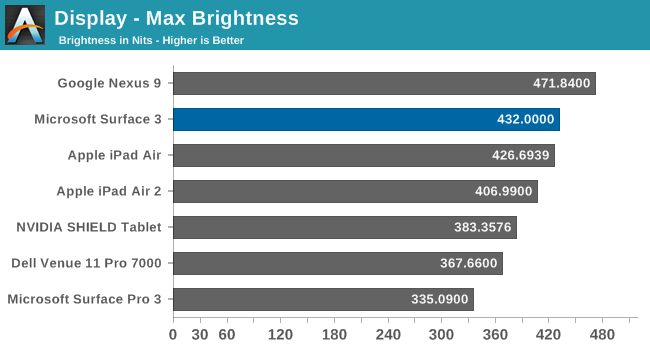
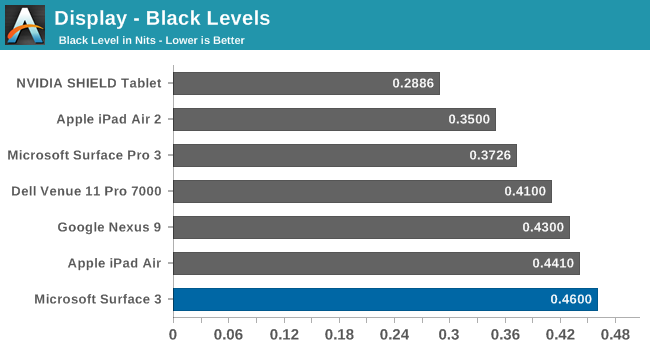
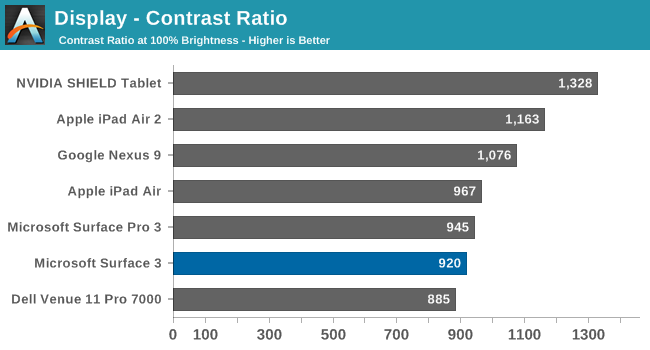
The Surface 3 gets quite bright, coming in at 432 nits at maximum output. The black levels are a bit high, but overall contrast is a decent 920:1. This makes the Surface 3 almost 100 nits higher than the Surface Pro 3 that Anand reviewed last year, which is a good start for this less expensive version.
Grayscale
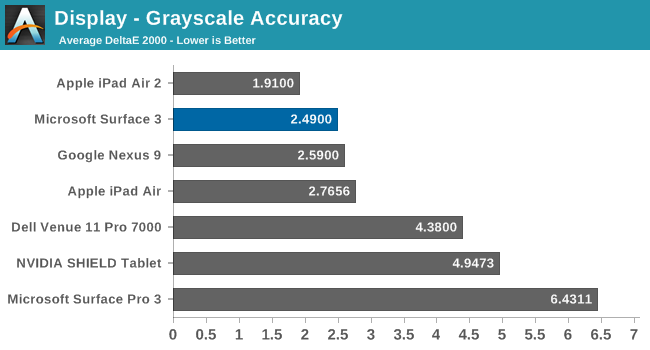
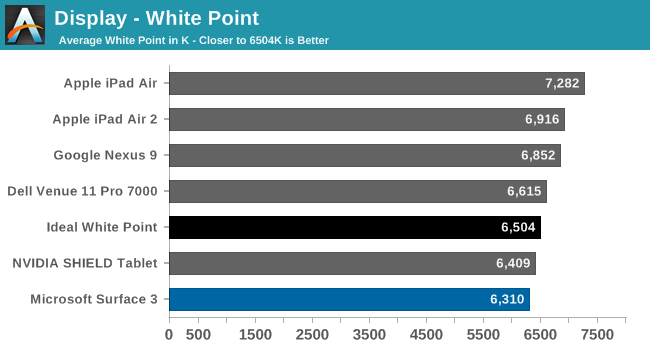
The grayscale average for the Surface 3 is very good, coming in just about at 2.5 as an average for the sweep. There is a bit of a spike at 25% but it is not indicative of the overall calibration. Gamma is a bit low, but the white point is fairly close to the ideal value.
Saturation
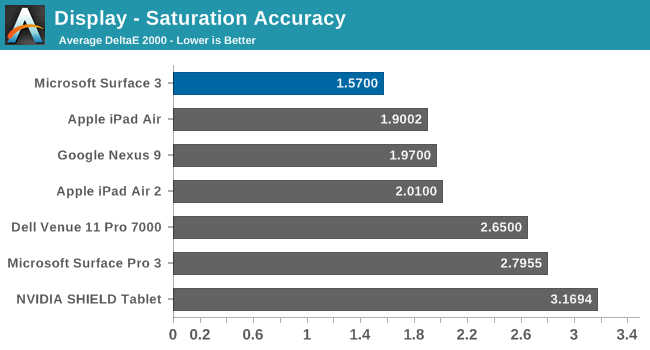
The accuracy on our saturation tests is outstanding, with an overall average score of just 1.57. Looking at the individual colors, the red is a bit oversaturated at 100%, and blue tends to be undersaturated, but the amount of error is very small.
Gamut and Gretag Macbeth
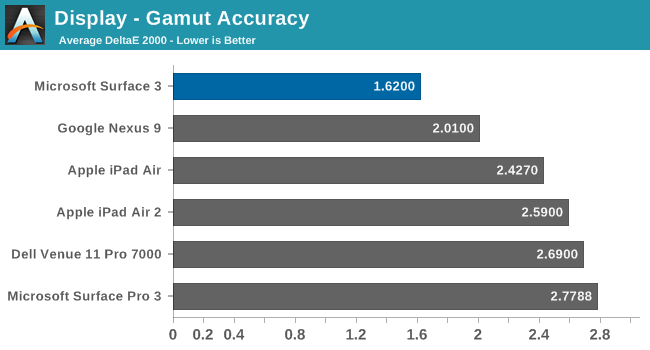
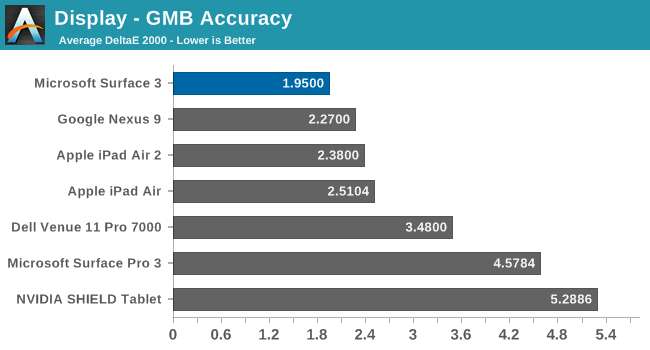
Once again the Surface 3 comes in with fantastic scores on these two tests, with the comprehensive GMB test under 2. When we are doing these tests, values under 3 are considered good, and the Surface 3 has passed with amazing scores. The best part of this is that all of this is done without the use of an ICC profile, so that means the hardware is being calibrated directly. ICC profiles can fix some issues, but not all programs respect them so having it done in hardware is a much better option.
Calibrated
Since this is a full x86 Windows operating system, we can also calibrate the display with the CalMAN software. Even though it was very good out of the box, the calibration pulls it even closer to perfection.
Surface 3 has one of the most accurate displays we have ever tested, which is great to see in what is considered the value member of the Surface family. Microsoft promised an accurate display and they have delivered.


















265 Comments
View All Comments
Brett Howse - Tuesday, May 5, 2015 - link
Windows Video app is used, and the file properties are listed on the graph. Let me know if you need anything else.MarcSP - Thursday, May 7, 2015 - link
No, that will be all. Dismised. :PHe, he. Thank for your reply! :-)
dusk007 - Monday, May 4, 2015 - link
One would wish Intel would just license the Mali GPUs or PowerVR designs. Even with 14nm they cannot keep up with Nvidia, Apple or any of the faster Adreno or Mali 760 SoCs.Also there doesn't seem to be any improvements. Their GPU design is not very power efficient and seemingly not even die space efficient but there are no real noticeable improvements between Gen 7 and 8. They should just go back to licensing or just buy Imagination Technologies.
Drumsticks - Monday, May 4, 2015 - link
Correct me if I'm wrong but don't skylake rumors include huge GPU strides?A5 - Monday, May 4, 2015 - link
Big grain of salt on that. Similar rumors were around for Haswell and Broadwell, too.lilmoe - Monday, May 4, 2015 - link
You'd think they'd at least get the GPU at performance parity with AMD's APUs by now....meacupla - Monday, May 4, 2015 - link
I think intel GPU performance is better than AMD APUs. Intel's solution does hardware video playback without sucking down enormous amounts of power.I won't even go into gaming, since both solutions are, flat out, subpar for that.
anubis44 - Monday, May 4, 2015 - link
Utterly wrong. AMD's Radeon GPU technology in their APUs crushes Intel's fastest integrated graphics. No comparison. Don't even try.meacupla - Tuesday, May 5, 2015 - link
That's not what I'm saying. Please read.AMD is faster, but at the cost of power and efficiency. And it still won't give you a good gaming experience, because there's not enough of everything in APUs.
Intel is slower, but gets the job done with regards to video, there was no question of it being gaming capable in the first place.
lilmoe - Tuesday, May 5, 2015 - link
Efficiency isn't AMD's fault. Intel's had the process lead for more than 2 generations now and they're STILL not even close to AMD's GPU performance... We'll see how efficient Intel's GPU is when AMD goes 14nm....